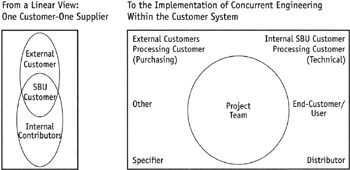From Demand-Pull Projects to Design-Push Projects
|
From "Demand-Pull" Projects to "Design-Push" Projects
The classical project paradigm is a demand-pull design model. It organizes the mobilization of professionals to answer explicit demands from project owners. But in our specific economic context it is more a design-push process than a market-pull one. Innovations like the Walkman by Sony, Post-it Notes by 3M, or Navigator by Netscape were not designed as an answer to an explicit question of existing customers. Generally, innovation strategies are more proactive to market signals than reactive. Thus, implementation of the traditional project management model is problematic in cases of radical breakthrough and emerging phases of innovation. In that situation, the innovation process includes the elaboration of the demand or question, at the same time as the definition of the answer.
Taking the concepts from Simon (1969) and Schon (1983), prominent theorists in the field of design activity, we could say that the "problem setting" side of the design activity is as much (and sometimes even more) important than the "problem solving" side. (The Post-it Note case is typical of an extreme situation. The key question was to find a valuable use for a paste that already existed. In "how" words, the answer existed, what was to be invented was the question that fitted with it.) Therefore, the asymmetry of the economic relation between the owner-customer and the contractor-supplier creates a bias to the need of a symmetric and dialectic exploration of setting and solving of the problem.
What are the consequences of such theoretical arguments on the practical structuring of research and development (R&D) projects in firms? The evolution of the French chemical group Rhone-Poulenc can illustrate this point (Charue-Duboc 1997). Until the '80s, R&D were clearly in a science and technology push logic with central R&D departments. In the beginning of the '90s, the reorientation of the core chemical industry group toward production of innovative, high utilization value chemicals lead to a change in the type of projects conducted: from projects involving heavy industrial production toward product-focused research.
In order to implement this new strategy, a matrix structure with Strategic Business Units (SBU) and a decentralization move of R&D was implemented. The central share of R&D budgets is gradually declining, as budgets allocated by sector or SBU are rising. The philosophy was to "focus research on the market" by adopting the demand-pull traditional project model, with marketing people as project owners and research people as contractors. The limits of such a model for breakthrough projects appeared rapidly. Marketing people from SBUs were more focussed on incremental rather than radical innovations. Many interesting innovative ideas from the researchers could hardly the financed in this situation because the innovation did not fit in with the existing market segmentation and responsibilities (generally, the market gets restructured as a result of breakthrough innovation). Marketing people did not have the skills to help the exploration of new valuable functionalities.
A new step was implemented to overcome these problems. New research units were created, not in order to synthesize products, but to analyze functional and utilization characteristics (application and "applicability" laboratories). The project patterns moved from a demand-pull contractual model to a more design-push model, which emphasized the role of applicability researchers, and also adopted a more symmetrical and integrated vision of the marketing and research part of the project. Let us insist on the fact that this move is not a come back to the science push logic of the '60s, but a new model fitted to meet the modern, proactive strategies of innovative features and technologies.
This design-push project model spread beyond the firm's frontier by the setting of exploration partnerships with customers. The goal was to succeed in mobilizing customers' expertise for the exploration of potential utilization values and the final development of new products. We are moving here from a linear view of the downstream value chain towards "customer system concurrent engineering" as represented in Figure 3.

Figure 3: Evolution in Customers System from Linear to Concurrent Approach
Setting up design-push partnerships is more difficult than demand-pull ones. In the manufacturing sector, the initiative for new design approaches comes from the end firms in the chain. They are able to compel their suppliers to use a concurrent engineering approach by wielding their power as buyers. The situation is obviously different for upstream firms, as projects usually require coordinating downstream customers or specifiers rather than upstream suppliers. How can customers be convinced to take part when, as is usually the case, it is not possible to exercise financial leverage over the downstream part of the chain?
|
EAN: 2147483647
Pages: 207